By Bob Ferris
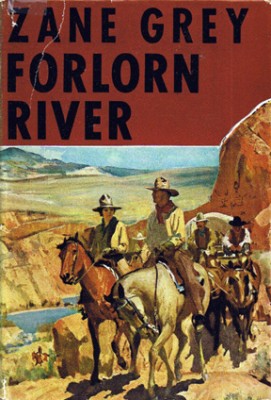 I became convinced yesterday that actors who play zombies in movies learned their walking techniques from fly fishermen wading in swift rivers on slippery and slimy cobble. I came to that conclusion as I “gingerly” crossed the North Fork of the Middle Fork of the Willamette River—it is all in the balance or lack thereof. But this summer seems to have been a season of lessons taught or inspired by the rivers my wife and I roamed in July, August and September.
I became convinced yesterday that actors who play zombies in movies learned their walking techniques from fly fishermen wading in swift rivers on slippery and slimy cobble. I came to that conclusion as I “gingerly” crossed the North Fork of the Middle Fork of the Willamette River—it is all in the balance or lack thereof. But this summer seems to have been a season of lessons taught or inspired by the rivers my wife and I roamed in July, August and September.
Our first plans this summer were to go down the Wild and Scenic portion of the Rogue. Since this is the site of Zane Grey’s cabin and we tend to get regionally inspired recorded books for our trips we checked out Grey’s Forlorn River for a listen. But this year’s fires forced a migration to the Lower Salmon and Snake Rivers of Idaho, Oregon and Washington. As this was sort of last minute we still took the story of Ben Ide and Ina Blaine along with us for a listen.
Forlorn River is certainly about rustlers and romance but it is also about drought and the over-riding importance of water. It is a tale of how little weather blimps—like a six-year drought—can make profound differences when it comes to the livelihoods and welfare of people and wildlife. We got about a third through the CDs on our trip to the launch site at White Bird, Idaho. Grey’s descriptions of fried landscapes and denuded slopes around a de-watered Tule Lake resonated as we rowed past hillside after hillside rich with cattle hoof prints and cow flops but much bereft of plant life.
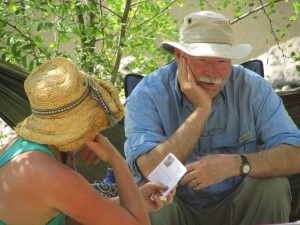
We spent a layover day after our second day of raft rowing and the five of us in our party hid in the thorny locust trees and watched the REI thermometer top 112 degrees in the shade. The steep, dark canyon walls seemed quite capable of turning our little refuge into the Neolithic equivalent of an easy-bake oven. It made me think—as I often do—about the implications of climate change and the importance of doing all that we can to limit the use of fossil fuels. Parboiling in our shady version of Hades somehow gives special validity to all our efforts to stop pipelines and coal terminals.
We also ran into a BLM fellow during our series of siestas. In amongst the chit-chat and his questions about our compliance with poop-rules and other river regulations, I asked him about suction dredgers on the Salmon. His response was similar to other responses that I have received from other agency folks in that unarmed officers are understandably reticent to perform enforcement actions on heavily armed public lands users. Strikes me as a sad state of affairs.
It is about weather but also water too. Our boats clanked and clunked through the various rapids as they were festooned with water bottles of all ilks. And you can tell a lot about people by their water bottles. Ours bespoke folks who supported energy conservation programs in Oregon and Washington, wildlife preservation and organic farming—mostly metal, well used and dented. These are the modern day equivalents of the saddle blanket-sided canteens of Ben and Ina’s days.
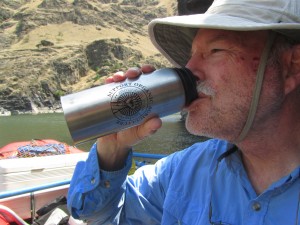
We drank deep and often in the searing heat along our 75-mile trip (see water bottle above from business partner Mountain Rose Herbs). And it was so easy to imagine the craziness and desperation experienced by those without water in these conditions. Our Tully’s and booney hats replaced the big, broad sombreros of the Forlorn River crew, but it was clear that without water their personal shade would be but a short stopgap.
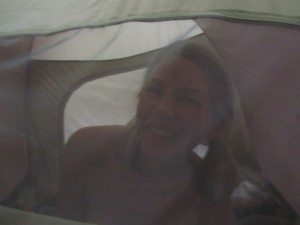
My thoughts returned to climate change again on our last night on the Snake—the day we rowed from Idaho to Oregon and then into Washington. We stopped short of our goal on a tiny little beach because a head wind was beating the current and our rowing. My friend Martin and I were building shoulders, but not making progress. Tired as we were we both hopped up when we looked at the quickly blackening sky and scrambled to erect tents and batten down whatever “hatches” were open. My wife questioned our haste and my bossiness as I shoved her and our gear into the tent, but when the angry skies unleashed the need for speed became readily apparent.
Our once quiet, sweltering and a little buggy beach quickly became like the stormy deck of a besieged ship as the wind and rain whipped us. I became a giant, wet tent stake as I held on to top of our tent to prevent ripped fabric and sprung poles. Then the calm came and we took a breath only to have the trailing edges of the storm blow us just as hard in the other direction.
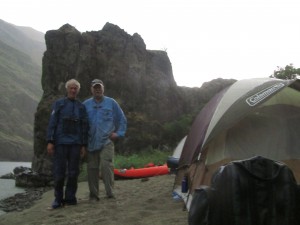
We emerged wet and much cooler, but suspected that gear from some camps that afternoon flew miles before stopping. The bugs too were gone and there was a freshness felt. But I could not help but think about storm intensity and climate change essentially: What have we wrought though our consumptive ways and how justified the sky is in giving us the grief it does.
Following our return from the Salmon and Snake Rivers, the rest of Forlorn River CDs sat unspun until Carlene and I finally traveled down to the Rogue. This time we went to go rafting from Hog Creek to Grave’s Creek with a bunch of environmental law students from University of Oregon. When I say bunch I mean 70 or so. This is always a rowdy trip and not because of the river which only slaps us with Class I & II rapids in this stretch. It is a good float and nice to see this potential crop of environmental lawyers out in the habitats they will work so hard to protect in the future.
It is also a time for discussions and bonding; for the river opens as well as it binds. Paddling is a team sport as people have to paddle together to make progress and also have to develop both as leaders and followers to make it work in the manner that it should. No one is going to die but there are consequences when it does not work. It is also intriguing to see—one by one—why each of the students is there and what makes them special. It could be the shy talker who belts out a ballad next to the campfire or the timid and hesitant leaper who seems hesitant to jump off the lower level of the rock plunge only to nail a bold backflip with a perfect entry. I am along as mentor and guide, but in truth I do very little of either. I learn much from the discussions and their commitment deepens my own resolve.
And again the CDs sit, but only for less than a day for we soon scoot off to spend an afternoon on the North Fork of the Middle Fork of the Willamette up past Westfir. We are midway through Forlorn River at this point and we revel at Marvie Blaine’s enthusiasm over fishing as the rainbows stack up in the last spring holes of Forlorn River. Knowing what I do about Zane Grey’s life and his dedication to angling, I suspect that there is a lot of him in young Marvie and his willingness to take a “licking” in pursuit of his passion. I get that because I was bitten by the same bug.
The last spring hole is also a contemporarily appropriate metaphor. We are in so many areas down to our last spring hole and the fish really have no place else to go. In my own North Fork wading and wandering looking for that legal-sized keeper native, I stumbled onto about a dozen or so nearly yard-long salmonids beaten and bruised from their long journeys. My emotions upon seeing these great fish were mixed. I was at once excited and empathetic as well as depressed and resigned when it dawned on me that these fish—brave and majestic as they were—represented some of the problem and our folly as these were most likely summer run steelhead from hatcheries judging from their lack of adipose fins. It is kind of like looking up a slope and seeing shapes you hope are elk and finding they are cattle—not completely the same but similar. Elation and deflation.
The CD spun to romance as we drove home and a coming together for Ben and Ina with hopeful undertones for the triumph of good over evil and right over wrong. I hope as we re-enter the world of wolves, O&C lands and salmon recovery that this Forlorn River theme can prevail. We still have about twenty percent of the book to hear so we are obviously obligated to visit another river or two soon. I wonder which waterway it will be and what lessons it will teach?
